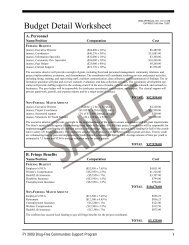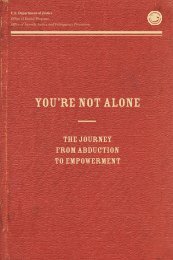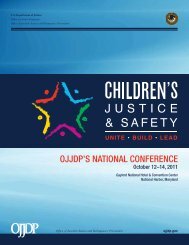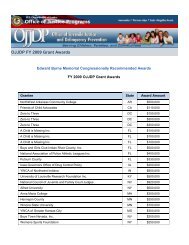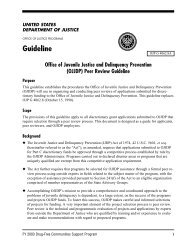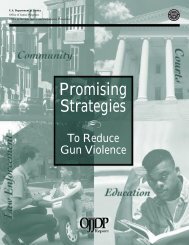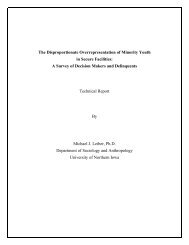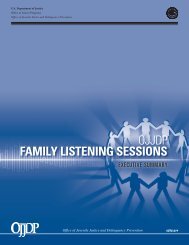Juvenile Court Statistics 2005. - Office of Juvenile Justice and ...
Juvenile Court Statistics 2005. - Office of Juvenile Justice and ...
Juvenile Court Statistics 2005. - Office of Juvenile Justice and ...
- No tags were found...
You also want an ePaper? Increase the reach of your titles
YUMPU automatically turns print PDFs into web optimized ePapers that Google loves.
Chapter 2: National Estimates <strong>of</strong> Delinquency CasesRaceCase rates for drug <strong>of</strong>fenses increased dramatically for all age groups within each racial category duringthe 1990sDrug <strong>of</strong>fense case ratesCases per 1,000 juveniles in age group20White161284Age 17Age 16Ages 13–15Ages 10–12 (x5)*01985 1990 1995 2000 2005Cases per 1,000 juveniles in age group50Black40Age 1730Age 162010Ages 13–15Ages 10–12 (x5)*01985 1990 1995 2000 2005Cases per 1,000 juveniles in age group16Amer. Indian128Age 17Age 16Ages 13–15Cases per 1,000 juveniles in age group5Asian432Age 17Age 16Ages 13–154Ages 10–121Ages 10–12 (x5)*01985 1990 1995 2000 200501985 1990 1995 2000 2005■■For white youth, drug <strong>of</strong>fense case rates increased dramaticallyfor all age groups between 1991 <strong>and</strong> 2001:439% for 10- to 12-year-olds, 372% for 13- to 15-yearolds,305% for 16-year-olds, <strong>and</strong> 258% for youth age 17.Between 2001 <strong>and</strong> 2005, case rates declined for all agegroups: 21% for 10- to 12-year-olds, 13% for youth ages13–15, 9% for juveniles age 16, <strong>and</strong> 7% for youth age 17.Despite these declines, the 2005 drug <strong>of</strong>fense case ratesfor white youth <strong>of</strong> all ages were more than double therates in 1985.Drug <strong>of</strong>fense case rates for black youth generallyincreased for all age groups into the 1990s, reaching apeak in 1998 for youth age 17 <strong>and</strong> in 1996 for youngerjuveniles. Between the peak <strong>and</strong> 2005, drug <strong>of</strong>fense caserates for black youth decreased for all age groups: 22%■■for youth ages 10–12, 32% for youth ages 13–15, 27%for juveniles age 16, <strong>and</strong> 18% for youth age 17.Drug <strong>of</strong>fense case rates for American Indian youthincreased dramatically for all age groups between1991 <strong>and</strong> 2002 <strong>and</strong>, with the exception <strong>of</strong> 10- to 12-year-olds, continued to increase through <strong>2005.</strong> ForAmerican Indian youth ages 10–12, the drug <strong>of</strong>fensecase rate decreased 14% between 2002 <strong>and</strong> 2005,while the rates increased 16% for juveniles ages13–15, 5% for 16-year-olds, <strong>and</strong> 6% for 17-year-olds.Age-specific drug <strong>of</strong>fense case rates for Asian youthfollowed a pattern similar to that <strong>of</strong> American Indianjuveniles.*Because <strong>of</strong> the relatively low volume <strong>of</strong> cases involving youth <strong>of</strong> all races ages 10–12 for drug <strong>of</strong>fenses, their case rates are inflated by afactor <strong>of</strong> 5 to display the trends over time.24<strong>Juvenile</strong> <strong>Court</strong> <strong>Statistics</strong> 2005


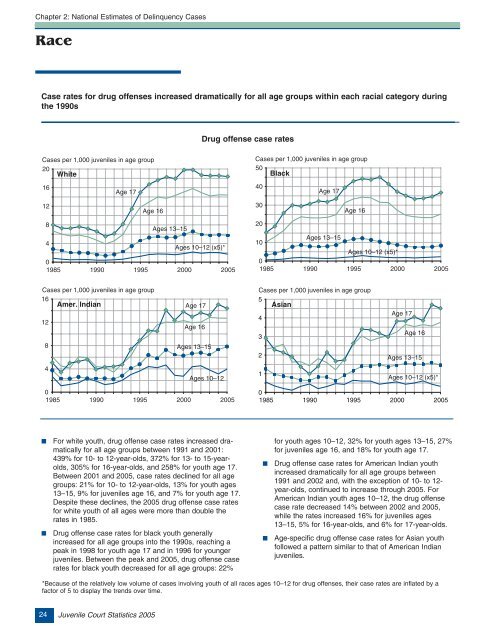
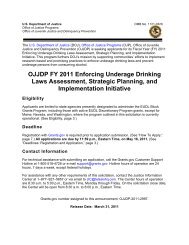

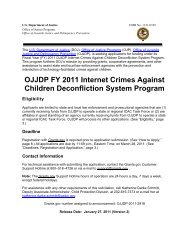
![Chapter 5 [PDF] - Office of Juvenile Justice and Delinquency ...](https://img.yumpu.com/46584340/1/190x245/chapter-5-pdf-office-of-juvenile-justice-and-delinquency-.jpg?quality=85)
